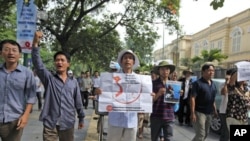Asia’s surging economies are hungry for natural resources and that is drawing new attention to the reserves that lie under the South China Sea. Bordering countries have long disagreed over control of the sea, but new oil and gas exploration efforts are worsening tensions. Some countries will take the dispute to the coming meeting of the Association of Southeast Asian Nations (ASEAN).
When a Chinese vessel cut an exploration cable off a Vietnamese survey ship that was searching for oil in the South China Sea in May, tensions quickly ratcheted up. Vietnam responded by conducting live-fire exercises in the area, and protests erupted in Vietnam and the Philippines against what those governments called China’s assertiveness.
It was not the first time disputes over the region stirred controversy. Vietnam and China fought a sea battle in the area in 1988. China considers all of the South China Sea its “indisputable” territory.
Strategic importance
But Vietnam, the Philippines, Malaysia, Brunei, and Taiwan also claim all or part of the South China Sea.
The area is one of the world’s busiest sea lanes, but its oil and gas reserves make it even more important to countries that are intent on shoring up their energy security.
Yang Fang, an associate research fellow studying maritime security at the S. Rajaratnam School of International Studies in Singapore, he said, “On the one hand, China has a growing demand for energy, and on the other hand, Vietnam, the Philippines and Malaysia have all extracted lots of resources in the South China Sea. Consequently, China is increasingly using maritime law enforcement agencies to defend its maritime interest.”
But as economic interests clash, the danger of armed conflict increases. China’s naval might is growing, and Vietnam and Malaysia are increasing their capabilities with new submarines.
Naval presence
In recent years, Chinese officials repeatedly have emphasized they want to cooperate with neighbors to resolve differences.
Carolina Hernandez, a defense analyst at the Philippine Institute for Strategic and Development Studies, said a military build-up is needed should cooperation fail.
“We will get whatever we can get in terms of good relations with China, but most of us will keep some kind of insurance policies," she said. "Don’t put all your eggs in the cooperation basket because world politics is not like that.”
In his trip to Beijing this month, the Chairman of the U.S. Joint Chiefs of Staff Admiral Mike Mullen warned of a miscalculation in the area that could lead to violence.
Some regional analysts say that risk is low, however, because it would disrupt oil drilling. James Nolt, campus dean of the New York Institute of Technology in Nanjing, said, “It’s not going to be possible for anyone to produce oil from the South China Sea region if it’s a region of conflict and war, because oil companies are not going to risk their expensive assets in a war zone. So the only way any of the countries in the region can get anything is if they exploit the resources cooperatively and peacefully.”
US influence
The United States said it remains committed to maintaining freedom of navigation in the area and calls for a multilateral solution to the issue - an idea China rejects. Beijing has complained about what it calls the intervention of non-claimants in the dispute.
Later this month (July 15-23) defense officials and top diplomats from the Association of Southeast Asian Nations, China, the United States, Japan, South Korea and other ASEAN partners meet in Indonesia. The South China Sea is expected to be high on the agenda.
Some governments in the region have indicated they see ASEAN as the main platform for resolving the dispute. ASEAN worked with China in 2002 to come up with the Declaration on the Conduct of Parties in the South China Sea, which is considered the cornerstone of conflict-avoidance in the area.
Hernandez has doubts, though, about this.
“It [ASEAN] cannot solve the dispute. Not all 10 parties are members, there is the ASEAN 4 that are claimants and they have overlapping claims. The Declaration on the Conduct of Parties is maybe more a political declaration. It has norms but cannot be enforced,” said Hernandez.
ASEAN focus
Regional analysts say the next step for ASEAN is a binding code of conduct. But that is unlikely to materialize this year.
Yang Fang in Singapore said the United States’ interest in the matter complicates ASEAN’s role.
“ASEAN countries should try to manage the relationship between China and the U.S. on the South China Sea issue. On the one hand, they should recognize the U.S. interest in this region, on the other hand, they should not push China into one corner that it would get China out of this process,” said Yang Fang.
John Ciorciari, associate fellow at the Asia Society in New York, said that while China has increasing naval capability, it still cannot secure and hold territories for long periods of time, especially if the United States aids other claimants.
“China’s strategy has been to prevent other claimants from encroaching on the disputed area and planting their flags, so to speak, and so that it can bide time when it expects in the future it’ll have even greater capabilities and may be able to secure more concessions,” said Ciorciari.
Given the military and the economic concerns, experts on the region say the only appealing option is continuing talks, including at the ASEAN meeting this month.













